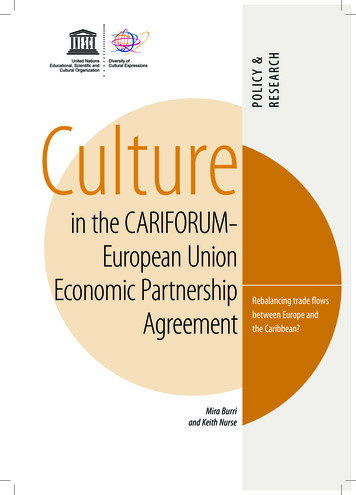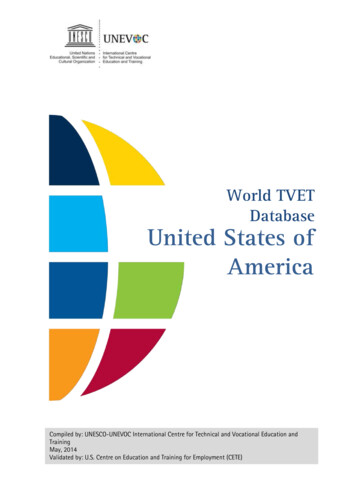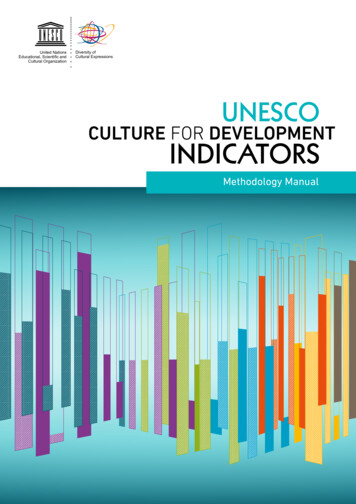
Transcription
in the CARIFORUMEuropean UnionEconomic PartnershipAgreementMira Burriand Keith NursePOLICY &RESEARCHCultureRebalancing trade flowsbetween Europe andthe Caribbean?
AuthorsThis study was conducted by Mira Burri (Senior Lecturer andManaging Director for Internationalisation at the Faculty ofLaw, University of Lucerne, Switzerland) and Keith Nurse(World Trade Organization Chairholder and Senior Fellow atthe Sir Arthur Lewis Institute of Social and Economic Studies,The University of the West Indies, Barbados).Editorial teamDanielle Cliche (Secretary of the 2005 Convention on the Protection and Promotion ofthe Diversity of Cultural Expressions, Chief of Diversity of Cultural Expressions Entity),Lindsay Cotton (Associate Project Officer, Diversity of Cultural Expressions Entity),Lydia Deloumeaux (UNESCO Institute for Statistics, Associate Programme Specialist),Anthony Krause (Chief of Policy and Research Unit, Diversity of CulturalExpressions Entity), Berta de Sancristóbal (Project Officer, Diversity of CulturalExpressions Entity). Thanks to Véronique Guèvremont (Professor, Faculty of Law atLaval University, Quebec, Canada) for her contribution.Published in 2019 by the United Nations Educational,Scientific and Cultural Organization,7, place de Fontenoy, 75352 Paris 07 SP, France UNESCO 2019This publication is available in Open Access under the Attribution-ShareAlike 3.0 IGO(CC-BY-SA 3.0 IGO) license /).By using the content of this publication, the users accept to be bound by the termsof use of the UNESCO Open Access Repository -fr).The designations employed and the presentation of material throughout thispublication do not imply the expression of any opinion whatsoever on the partof UNESCO concerning the legal status of any country, territory, city or area orof its authorities, or concerning the delimitation of its frontiers or boundaries.The ideas and opinions expressed in this publication are those of the authors;they are not necessarily those of UNESCO and do not commit the Organization.Cover and graphic design: Corinne HayworthPrinted in FranceThis publication was made possible with support from the UNESCO-AschbergProgramme for Artists and Cultural Professionals.2FLOWS ANDMOBILITY4HUMANRIGHTSUNESCO-Aschberg Programmefor Artists and Cultural Professionals
Table of ContentsForeword5Key findings9Introduction111 T he CARIFORUM-EU EPA: Fostering preferentialtreatment in cultural trade and cooperation. . . . . . . . . . . . . 17Granting market access for entertainment services18The Protocol on Cultural Cooperation:Redesigning external trade practices202 Forging new institutional frameworks . . . . . . . . . . . . . . . . . . 25Joint institutions under the EPA26Building on the European Union’s institutional landscape29Increasing institutional support in the Caribbean31General overview36Cultural provisions in the CARIFORUM-EU EPA:how binding are the rules?40Putting funding structures in place42Facilitating market access for entertainment services46The Protocol on Cultural Cooperation (PCC) andaudiovisual co-productions: An unexplored opportunity50Trends in cultural trade flows52Building frameworks for exports and trade60Conclusion69Recommendations72AnnexesAnnex 1 Title II: Investment, trade in services and e-commerceAnnex 2 Protocol III on cultural cooperation7576105Culture in the CARIFORUM-EU EPA3 M ind the gap? New steps towards implementingthe CARIFORUM‑EU EPA . . . . . . . . . . . . . . . . . . . . . . . . . . . . . . . 353
ForewordThe provision on preferential treatment for developingcountries (Article 16) is known to be one the most bindingand powerful of the UNESCO Convention on the Protectionand Promotion of the Diversity of Cultural Expressions (2005),now ratified by 145 countries around the world and theEuropean Union.Preferential treatment policies and measures are understoodas those that either promote the mobility of artists and othercultural professionals and practitioners, or improve market accessfor cultural goods and services from developing countries.The potential of Article 16 can be key to realizing the 2005Convention’s objectives and can be developed in differentdirections that would address individuals, industries andinstitutions1.While the potential of Article 16 in contributing to dynamiccultural exchanges with long-lasting effects in both developedand developing countries is evident, its actual implementationand impact on the ground remain underdeveloped andunderexplored.1. See “Culture in Treaties and Agreements. Implementing the 2005 Convention in Bilateraland Regional Trade Agreements”, Véronique Guèvremont and Ivana Otašević, UNESCO,2017.Culture in the CARIFORUM-EU EPAThe goal of preferential treatment measures is to facilitate themobility and exchange of artists and cultural professionals fromthe global South, through, for example, simplified proceduresfor visas or lower visa costs. Aimed at the cultural and creativeindustries, preferential treatment measures are to improvemarket access for cultural goods and services from developingcountries through capacity building for cultural entrepreneursand organizations that promote the economic and tradedimension of the sector and through specific support schemesto open market access, such as co-distribution agreements.Finally, preferential treatment measures are to be addressedbeyond the culture sector, in other international institutions orforums, as well as through other policies and instruments suchas bilateral, regional, multilateral trade agreements.5
This study conducted by Mira Burri and Keith Nurse,which examines the Economic Partnership Agreement (EPA)concluded in October 2008 between the European Union (EU)and CARIFORUM States, seeks to fill this gap.This agreement was one of the first North/South regionaltrade agreements compatible with World Trade Organization(WTO) rules seeking to effectively improve market accessopportunities and ensure wider and more balanced exchanges.It was also the first to implement many of the 2005 Conventionobjectives through a dedicated Protocol on CulturalCooperation (PCC).A detailed analysis of the first five years of EPAimplementation (2008-2013) can be found in the external studyconducted for the EU in 2013-20142. A second evaluation of theimplementation and impact of the agreement (2008-2018) willbe conducted in 2020. However, culture was never includedwithin the scope of analysis.A joint system for monitoring the PCC is now beingcontemplated by both EPA partners. This study is a modestattempt to gather new information and data, analyse advancesand challenges, collect testimonies from key policy andindustry stakeholders, and offer some recommendations forpolicy action.This review, funded under the UNESCO-Aschberg Programmefor artists and cultural professionals, concerns the 146 Parties tothe 2005 Convention, who have committed to address issues ofculture and sustainable development in their trade agreements.Culture in the CARIFORUM-EU EPAThe objective is to produce a better understanding of thedegree to which the 2005 Convention can be used within atrade framework in order to provide developing countrieswith insight that can be used in their negotiating spaces.It is also designed to inform policy action for the attainment ofthe UN 2030 Agenda on Sustainable Development, in relationto SDG Goals 83 and 104 for inclusive and sustainable economicgrowth and reduced inequalities among countries.62. Monitoring the implementation and results of the CARIFORUM-EU ober/tradoc 152825.pdf3. Target 8.A: Increase Aid for Trade support for developing countries, in particular leastdeveloped countries, including through the Enhanced Integrated Framework for TradeRelated Technical Assistance to Least Developed Countries.4. Target 10.A: Implement the principle of special and differential treatment for developingcountries, in particular least developed countries, in accordance with World TradeOrganization agreements.
The authors reveal that all opportunities arising from theCARIFORUM-EU EPA provisions have not been fully exploitedand that the Protocol on Cultural Cooperation has yet to beactivated – especially those related to the movement ofartists and co-productions in the audiovisual sector. Yet, themessages emanating from EU and CARIFORUM personalitiesalso confirm an immense political will to increase effortstowards advocacy and operationalization.This study therefore also acts as a wake-up call forawareness raising. This is why the 2005 Convention Secretariatis currently working with the UNESCO Chair on the Diversityof Cultural Expressions (Laval University, Quebec, Canada) todesign a training module on preferential treatment in culture,for governmental officials, as well as trade negotiators, fromdeveloping countries.Collecting data and sharing information and best practicesfrom around the world is more critical than ever, especially ata time when the increasing dematerialization of the creativesectors is making it very challenging to obtain accurate dataon the trade flows of cultural goods and services.UNESCO, through its Global Report series “Re ShapingCultural Policies”, will continue to monitor progress andadvances5. To do so, it has revised the framework for QuadrennialPeriodic Reports (QPRs) that Parties to the 2005 Conventionsubmit every four years: specifically, Parties will be asked toreport on the ways in which cultural goods and services areprovided a special status in trade and investment agreements– including through preferential treatment provisions - towhich they are signatories or which are under negotiation,and provide information on the introduction of cultural clausesrelated to e-commerce and digital products.5. The 2005 Convention’s monitoring framework, under the “Treaties and Agreements”section, comprises three means of verification covering: special status for cultural goodsand services; cultural clauses related to e-commerce and digital products; and preferentialtreatment provisions.Culture in the CARIFORUM-EU EPADetermining impact is not an easy task. What were theexpectations? Who is effectively engaged? How directly orindirectly are the impacts attributable to the implementationof an agreement?7
May this new issue of the “Policy and Research” seriesencourage researchers, policy actors and cultural professionalsto engage further with UNESCO in order to explore the potentialof the 2005 Convention and advance the position of culture ininternational trade debates.Danielle ClicheCulture in the CARIFORUM-EU EPASecretary of the 2005 Convention on the Protection andPromotion of the Diversity of Cultural Expressions8
Key Findings The CARIFORUM-EU Economic Partnership Agreement(EPA) is unprecedented in its link to the UNESCOConvention on the Protection and Promotion of theDiversity of Cultural Expressions (2005 Convention) andin its attempt to include culture in a trade agreement. The CARIFORUM-EU EPA is the first regional tradeagreement that aims to implement Article 16 of the 2005Convention on preferential treatment for developingcountries, by including specific provisions for trade incultural and entertainment services and by adding adedicated Protocol on Cultural Cooperation (PCC). The CARIFORUM-EU EPA aims to facilitate market accessand preferential conditions for Caribbean cultural goods,services and practitioners and represents a higher levelof commitments by the European Union (EU) than inthe General Agreement on Trade in Services (GATS). Despite the significant commitments undertaken bythe EU, the EPA has not substantially improved marketentry and export earnings for CARIFORUM States thusfar, nor has it redressed the imbalance in the trade incultural goods and services between the two parties.The expected increase in cultural exchange, contributingto an increased diversity of cultural expressions,remains unseen. To improve market entry, both the EU and its MemberStates, as well as the participating CARIFORUM Statesmust take decisive steps to mobilize creative industryactors in order to increase transparency and simplifyprocedures, particularly in cross-border mobility.Culture in the CARIFORUM-EU EPA No dedicated funding or cultural cooperationprogrammes have been put in place to implement theEPA’s cultural provisions.9
There are certain short-term and long-term adjustmentsto be made in order to improve the implementationof the EPA, including activities to increase awareness,to improve dialogue between relevant institutions, andto develop tailored financial programmes and measurestargeting the CARIFORUM creative industries. Complete ratification of the EPA by the EU and CARIFORUMMember States, combined with enhanced communicationand exchanges among key strategic stakeholders atintergovernmental, governmental, industry and individualentrepreneur/artist levels, is necessary for long-termeconomic diversification, industrial upgrading, andsustainable cultural development. Effective implementation of preferential treatmentprovisions foreseen under the 2005 Convention, throughthe CARIFORUM-EU EPA, can decisively support the EPAsignatories in attaining the 2030 Agenda on SustainableDevelopment Goals (SDGs), in particular SDG 8 (target8.A on Aid for Trade) and SDG 10 (target 10.a on specialand differential treatment for developing countriesand least developed countries in accordance with theWTO Agreements).Culture in the CARIFORUM-EU EPA The implementation of the CARIFORUM-EU EPAoccurs in the context of the creative economy’s rapidtechnological transformation. This must be reflected inthe Parties’ instruments and strategies and contributeto a boost in digital entrepreneurship and marketintegration programmes.10
IntroductionThe CARIFORUM-EU Economic Partnership Agreement (EPA)is a free trade agreement concluded between CARIFORUMStates (14 CARICOM countries6 and the Dominican Republic)and the European Union (EU)7. It was signed in October 2008and has been provisionally applied since December 20088. TheCARIFORUM‑EU EPA replaces the trade provisions of the 2000Cotonou Agreement, through which the EU unilaterally grantedpreference to the African, Caribbean and Pacific (ACP) countries,in compliance with World Trade Organization (WTO) rules. Uponsigning the EPA, CARIFORUM became the first regional groupwithin the ACP to secure a comprehensive agreement withthe EU and its Member States and is the only EPA to includeprovisions on trade in services.The CARIFORUM-EU EPA is a “deep” free trade agreement.This means that it includes all economic sectors and covers tradein goods and services, investment, trade-related issues, such asinnovation, intellectual property and government procurement,sustainable development, as well as a comprehensive chapteron development cooperation. The agreement operates on anon-reciprocal basis – in the sense that the EU has opened itsmarket to a much greater extent than the Caribbean Stateshave. The Caribbean States have also benefitted from differenttransition periods, allowing for more time to implement theEPA. For trade in goods, the EPA reinforces and widens dutyfree quota-free (DFQF) access for CARIFORUM goods intoEU markets.6. Antigua and Barbuda; Bahamas; Barbados; Belize; Dominica; Grenada; Guyana; Jamaica;Saint Kitts and Nevis; Saint Lucia; Saint Vincent and the Grenadines; Suriname; Trinidad andTobago. Haiti signed the Agreement in December 2009 but has yet to ratify the EPA. All 28EU Member States have signed the EPA with Croatia joining in 2017.7. To date, 10 CARIFORUM States and 23 EU Member States have ratified the EPA.8. The full text is available at: do?fullText yes&treatyTransId 12969Culture in the CARIFORUM-EU EPAThe CARIFORUM‑EU EPA also contains a number ofprovisions and significant concessions in the services sectors,which is particularly important for the Caribbean – where insome countries, services represent more than 80% of GDP.11
Here, and again on the basis of asymmetrical liberalization,the EU opened 94% of its services sectors. In many areas, theconcessions go beyond what the EU has agreed upon underthe WTO umbrella in the framework of the General Agreementfor Trade in Services (GATS). The EPA provides improved marketaccess for Caribbean firms and professionals in terms of crossborder trade, investment, consumption abroad and temporarymovement of persons in business services, communications,construction, distribution, environmental, financial, transport,tourism and cultural and entertainment services.Beyond these extensive concessions in the trade of services,the EPA contains one novelty with a potentially significantimpact: the specific inclusion of the cultural sector in the tradeagreement. The impetus for the EPA’s new feature is directlylinked to the UNESCO Convention on the Protection andPromotion of the Diversity of Cultural Expressions (hereafter“2005 Convention”), which was adopted in 2005 and ratifiedby the EU, as a regional organization, in 2006.Convention on the Protection and Promotionof the Diversity of Cultural ExpressionsArticle 16 – Preferential treatment for developing countriesCulture in the CARIFORUM-EU EPADeveloped countries shall facilitate cultural exchanges with developing countriesby granting, through the appropriate institutional and legal frameworks,preferential treatment to artists and other cultural professionals and practitioners,as well as cultural goods and services from developing countries.12Article 16 in the body of the 2005 Convention is particularlynoteworthy, as it formulates a binding obligation for developedcountries to “facilitate cultural exchanges with developingcountries by granting, through the appropriate institutionaland legal frameworks, preferential treatment to artists andother cultural professionals and practitioners, as well as culturalgoods and services from developing countries.” This new call forlinking trade and culture and for rebalancing cultural exchangestriggered a major shift in the global trade discourse9.9. Keith Nurse, ‘The Economic Partnership Agreement and the Creative Sector: Implicationsand Prospects for Cariforum’ in The Cariforum-EU Economic Partnership Agreement:A Practitioners’ Analysis, A. Beviglia Zampetti and J. Lodge (eds), Kluwer International,London, 2011, pp.149-163.
The EU, as a key actor in endorsing the objectives of the2005 Convention, reacted accordingly and sought to adapt itstrade policy. The CARIFORUM-EU EPA is the clearest expressionof this shift and represents the first North-South regional tradeinstrument that takes into account the 2005 Convention’spreferential treatment obligation, under Article 16, and theclauses on cooperation for development under Article 14.The CARIFORUM-EU EPA seeks to tackle the structuraland asymmetrical imbalances in cultural exchanges The EPA advancedby helping CARIFORUM States enhance local creative cultural aspects raisedcapacities, increase the competitiveness of their hopes of generatingcultural creative goods and services, consolidate theirregional integration and increase their participation a dynamic of changein global trade.towards economicWith the CARIFORUM-EU EPA, European countries diversification andgranted market access to cultural and entertainment strategic industrialservices for CARIFORUM artists and cultural professionalsand annexed a special Protocol on Cultural Cooperation upgrading into facilitate partnerships and the exchange of cultural tradecultural activities, goods and services, including inthe audiovisual sector: “The CARIFORUM-EU partnershipagreement created an important precedent, particularlysince previous EU trade agreements contained virtually noreference to cultural cooperation. In this sense, it has shapedthe basis for international cooperation on cultural issues andcreative industries, taking into account the engagement ofthe international community as regards the implementationof the 2005 Convention and their commitment to respect andpromote cultural diversity10”.10. Edna dos Santos-Duisenberg, in The UNESCO Convention on the Protection and Promotionof the Diversity of Cultural Expressions, S. von Schorlemer and P.-T. Stoll (eds), Springer, 2012,386.11. See Keith Nurse, Allyson Francis and Keron Niles, ‘The EPA and Beyond: The Case forIndustrial and Innovation Policy’, Journal of Eastern Caribbean Studies (Special Issue onthe CARIFORUM–EU Economic Partnership Agreement) 33 (2008): 70-104; for voicesfrom the negotiators, see also Richard Bernal, ‘CARIFORUM–EU Economic PartnershipAgreement Negotiations: Why and How’, Journal of Eastern Caribbean Studies 33:2 (2008): 4;Owen Arthur, ‘The Economic Partnership Agreement between the CARIFORUM and theEuropean Union and the Building of a Post-Colonial Economy in the Caribbean’, Journal ofEastern Caribbean Studies 33:2 (2008), 27.Culture in the CARIFORUM-EU EPAThe EPA advanced cultural aspects raised hopes of generatinga dynamic of change towards economic diversification andstrategic industrial upgrading, in general and for concreteoutcomes, in cultural trade11.13
Convention on the Protection and Promotion ofthe Diversity of Cultural ExpressionsArticle 14 – Cooperation for developmentParties shall endeavour to support cooperation for sustainable developmentand poverty reduction, especially in relation to the specific needs of developingcountries, in order to foster the emergence of a dynamic cultural sector by, interalia, the following means:(a) the strengthening of the cultural industries in developing countries through:(i) creating and strengthening cultural production and distribution capacitiesin developing countries;(ii) facilitating wider access to the global market and international distributionnetworks for their cultural activities, goods and services;(iii) enabling the emergence of viable local and regional markets;(iv) adopting, where possible, appropriate measures in developed countrieswith a view to facilitating access to their territory for the cultural activities,goods and services of developing countries;(v) providing support for creative work and facilitating the mobility, to theextent possible, of artists from the developing world;(vi) encouraging appropriate collaboration between developed anddeveloping countries in the areas, inter alia, of music and film;(b) capacity-building through the exchange of information, experience andexpertise, as well as the training of human resources in developing countries, inthe public and private sector relating to, inter alia, strategic and managementcapacities, policy development and implementation, promotion and distribution ofcultural expressions, small-, medium- and micro-enterprise development, the useof technology, and skills development and transfer;Culture in the CARIFORUM-EU EPA(c) technology transfer through the introduction of appropriate incentivemeasures for the transfer of technology and know-how, especially in the areas ofcultural industries and enterprises;14(d) financial support through:(i) the establishment of an International Fund for Cultural Diversity asprovided in Article 18;(ii) the provision of official development assistance, as appropriate, includingtechnical assistance, to stimulate and support creativity;(iii) other forms of financial assistance such as low interest loans, grants andother funding mechanisms.
The questions addressed in this study are set against thisbackdrop. It seeks to evaluate whether the EPA, ten years intoits implementation, has made a substantial and measurableimpact on cultural trade relations between CARIFORUM Statesand the EU and whether governments, State and non-Stateagencies, industry bodies, individual firms and actors haveresponded to the opportunities created by the CARIFORUM‑EUEPA for a more culturally diverse environment.The study begins by outlining the EPA’s key provisions inthe field of culture. It then examines the institutional landscapeand focuses in particular on measures taken by EPA Partiesto implement its culture-related provisions. The overallperformance of the EPA so far is evaluated with data, practicesand other pieces of anecdotal evidence that may reveal theextent to which the EPA has had an impact on cultural activitiesand actors. It also identifies gaps or missed opportunities thatcan be addressed in future implementation strategies.Culture in the CARIFORUM-EU EPAPolicy recommendations conclude this study. This includesshort- to long-term measures to support the implementationof the EPA in the future. They have been formulated to renewhope that trade commitments and cultural policies canbe reconciled and can live up to the promises of the 2005UNESCO Convention and the 2030 Agenda for SustainableDevelopment.15
The CARIFORUM-EU EPA:Fostering preferentialtreatment in cultural tradeand cooperation117
Revisiting the relationship between trade and culturalcooperation, the CARIFORUM-EU EPA includes improvedmarket access and preferential treatment for culturalservices and cultural services providers through twoinnovative modalities (see Annexes): improved market access for entertainment servicesprovided by CARIFORUM States, as detailed in Title II“Investment, Trade in Services and E-commerce” a dedicated Protocol on Cultural CooperationCulture in the CARIFORUM-EU EPAGrantingmarket access forentertainment services18For the first time, the EU has committed to significantlyopening its entertainment sector to services and servicesuppliers from CARIFORUM States. The entertainment sectoris typically interpreted to include all entertainment servicesother than audiovisual - such as theatrical productions, musicalgroups, bands and orchestra entertainment services; servicesprovided by authors, composers, sculptors, entertainers andother individual artists; circus, amusement park and similarattraction services, ballroom, discotheque and dance instructionservices; and other entertainment services. The concessionsin the entertainment sector vary depending on the ‘mode ofsupply’, which refers to methods of providing a service12.12. Different modes of supply for entertainment services are covered in the EPA: crossborder supply of services (mode 1), commercial presence (mode 3), and temporarypresence of natural persons for business purposes (mode 4).
With regard to commercial presence (GATS mode 3, wherebya service is supplied through the establishment of the servicesprovider in the country where the service is provided), 16 EUMember States, including all of the major traditional marketsfor Caribbean entertainers, such as the United Kingdom,France, Germany, Italy and Spain, have granted preferentialaccess to investors or entertainment services companies fromthe Caribbean. Caribbean companies can also obtainwork visas for their managers or key personnel to For the first time, thework for their operations in an EU Member State for aEU has committed toperiod of up to 3 years (Article 81 – Key personnel andsignificantly openinggraduate trainees).its entertainmentAccess granted to Caribbean entertainers, artists andother cultural practitioners may be subject to qualificationrequirements and to economic needs tests (ENTs). Despitethese additional conditions, it should be underscored that thereis a comprehensive opening of the EU entertainment servicessector for the temporary entry of natural persons. It does notinclude quotas for EU Member States and is legally binding.Furthermore, this level of market access in the entertainmentsector – a sector that is part of the cultural domain and typicallya sensitive policy area – has never been granted by this manyEU Member States.Culture in the CARIFORUM-EU EPAThe EPA also includes specific opportunities forCaribbean entertainers and other artists to travel to sector to services andEU Member States in order to provide entertainment service suppliers fromas Contractual Service Suppliers (CSS) (Article 83– Contractual services suppliers and independent CARIFORUM Statesprofessionals). These are employees of a Caribbeancompany, which has no commercial presence or permanentoffice in the EU but has a contract to supply services toconsumers in an EU Member State and which requires itsemployees to enter an EU country on a temporary basis to fulfilthe contract. The scope is broad and Caribbean self-employedperforming artists who create a company through whichthey provide their services, can be considered CSS and arethus covered by EU commitments. Twenty-seven EU MemberStates (all except Belgium) have granted such access for theentertainment sector, with some transition periods appliedup to 2014.19
The Protocol onCultural Cooperation:Redesigning externaltrade practicesThe market access granted by the EU for entertainmentservices is complemented with a new and innovativeexternal trade practice instrument – the Protocol on CulturalCooperation (PCC)13. With the PCC, the CARIFORUM-EU EPAhas a particular significance as the very first international tradeagreement that makes an explicit reference to the provisionsof the 2005 Convention.The PCC, which is annexed to the EPA but is neither bindingnor subject to the general dispute resolution mechanisms, aimsabove all to improve “the conditions governing their exchangesof cultural activities, goods and services and redressing thestructural imbalances and asymmetrical patterns which mayexist in such exchanges”(article 1(2) PCC).Culture in the CARIFORUM-EU EPAIt provides for bilateral cooperation on all cultural fronts, suchas publications, sites and historic monuments and performingarts, and specifically includes activities particularly relevant tothe Caribbean, such as carnivals and costume design. The PCCalso has dedicated provisi
as bilateral, regional, multilateral trade agreements. While the potential of Article 16 in contributing to dynamic cultural exchanges with long-lasting effects in both developed and developing countries is evident, its actual implementation and impact on the ground remain underdeveloped and underexplored. 1. See "Culture in Treaties and .










